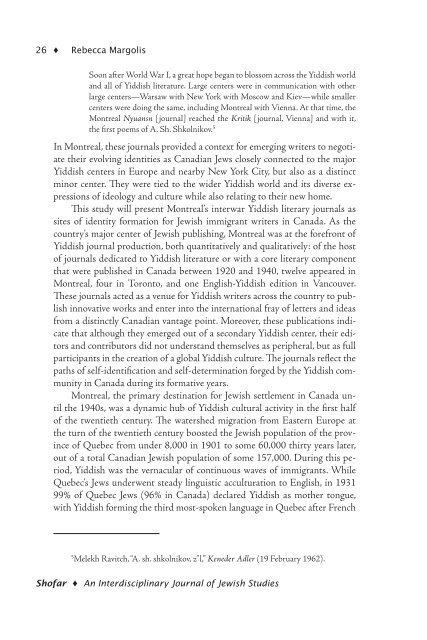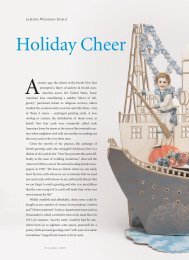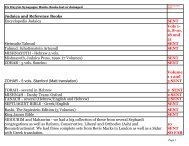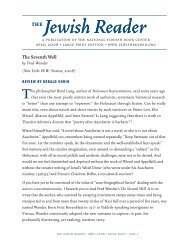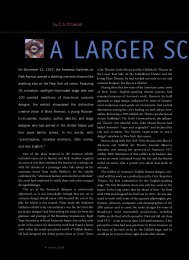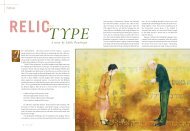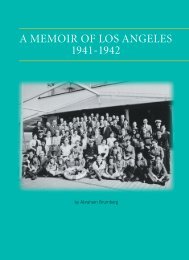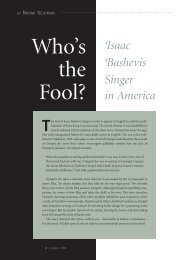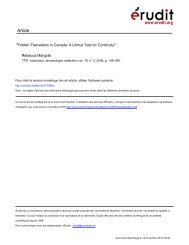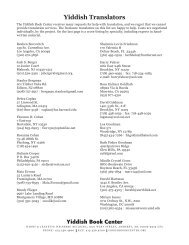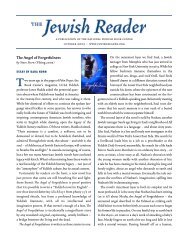Negotiating Jewish Canadian Identity Montreal Yiddish Literary ...
Negotiating Jewish Canadian Identity Montreal Yiddish Literary ...
Negotiating Jewish Canadian Identity Montreal Yiddish Literary ...
You also want an ePaper? Increase the reach of your titles
YUMPU automatically turns print PDFs into web optimized ePapers that Google loves.
26 ♦ Rebecca MargolisSoon after World War I, a great hope began to blossom across the <strong>Yiddish</strong> worldand all of <strong>Yiddish</strong> literature. Large centers were in communication with otherlarge centers—Warsaw with New York with Moscow and Kiev—while smallercenters were doing the same, including <strong>Montreal</strong> with Vienna. At that time, the<strong>Montreal</strong> Nyuansn [journal] reached the Kritik [journal, Vienna] and with it,the first poems of A. Sh. Shkolnikov. 5In <strong>Montreal</strong>, these journals provided a context for emerging writers to negotiatetheir evolving identities as <strong>Canadian</strong> Jews closely connected to the major<strong>Yiddish</strong> centers in Europe and nearby New York City, but also as a distinctminor center. They were tied to the wider <strong>Yiddish</strong> world and its diverse expressionsof ideology and culture while also relating to their new home.This study will present <strong>Montreal</strong>’s interwar <strong>Yiddish</strong> literary journals assites of identity formation for <strong>Jewish</strong> immigrant writers in Canada. As thecountry’s major center of <strong>Jewish</strong> publishing, <strong>Montreal</strong> was at the forefront of<strong>Yiddish</strong> journal production, both quantitatively and qualitatively: of the hostof journals dedicated to <strong>Yiddish</strong> literature or with a core literary componentthat were published in Canada between 1920 and 1940, twelve appeared in<strong>Montreal</strong>, four in Toronto, and one English-<strong>Yiddish</strong> edition in Vancouver.These journals acted as a venue for <strong>Yiddish</strong> writers across the country to publishinnovative works and enter into the international fray of letters and ideasfrom a distinctly <strong>Canadian</strong> vantage point. Moreover, these publications indicatethat although they emerged out of a secondary <strong>Yiddish</strong> center, their editorsand contributors did not understand themselves as peripheral, but as fullparticipants in the creation of a global <strong>Yiddish</strong> culture. The journals reflect thepaths of self-identification and self-determination forged by the <strong>Yiddish</strong> communityin Canada during its formative years.<strong>Montreal</strong>, the primary destination for <strong>Jewish</strong> settlement in Canada untilthe 1940s, was a dynamic hub of <strong>Yiddish</strong> cultural activity in the first halfof the twentieth century. The watershed migration from Eastern Europe atthe turn of the twentieth century boosted the <strong>Jewish</strong> population of the provinceof Quebec from under 8,000 in 1901 to some 60,000 thirty years later,out of a total <strong>Canadian</strong> <strong>Jewish</strong> population of some 157,000. During this period,<strong>Yiddish</strong> was the vernacular of continuous waves of immigrants. WhileQuebec’s Jews underwent steady linguistic acculturation to English, in 193199% of Quebec Jews (96% in Canada) declared <strong>Yiddish</strong> as mother tongue,with <strong>Yiddish</strong> forming the third most-spoken language in Quebec after French5Melekh Ravitch, “A. sh. shkolnikov, z”l,” Keneder Adler (19 February 1962).Shofar ♦ An Interdisciplinary Journal of <strong>Jewish</strong> Studies


